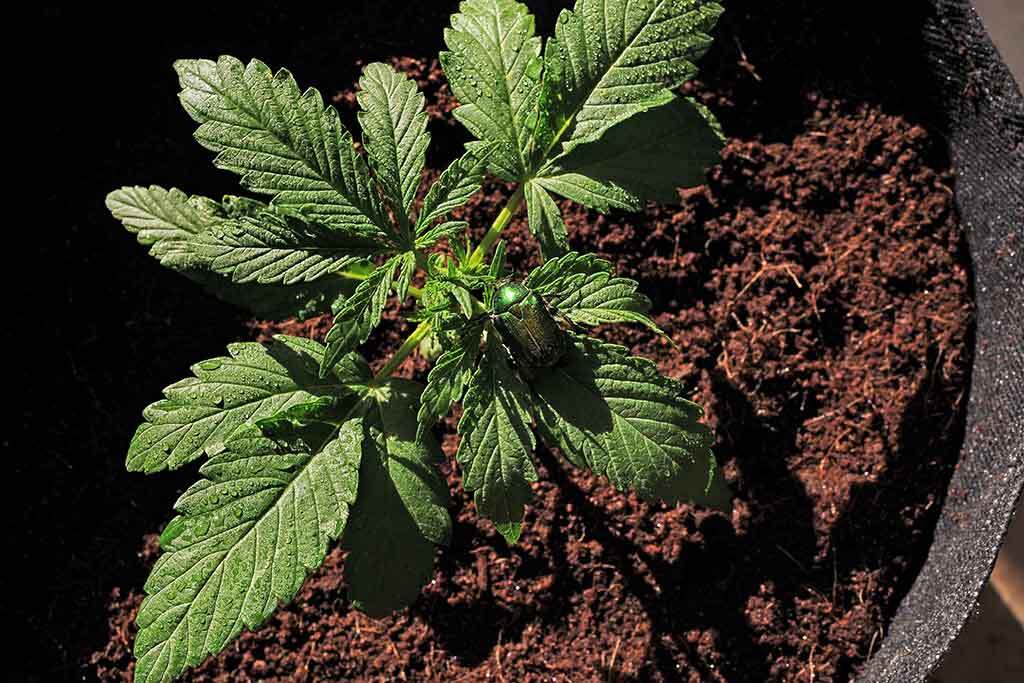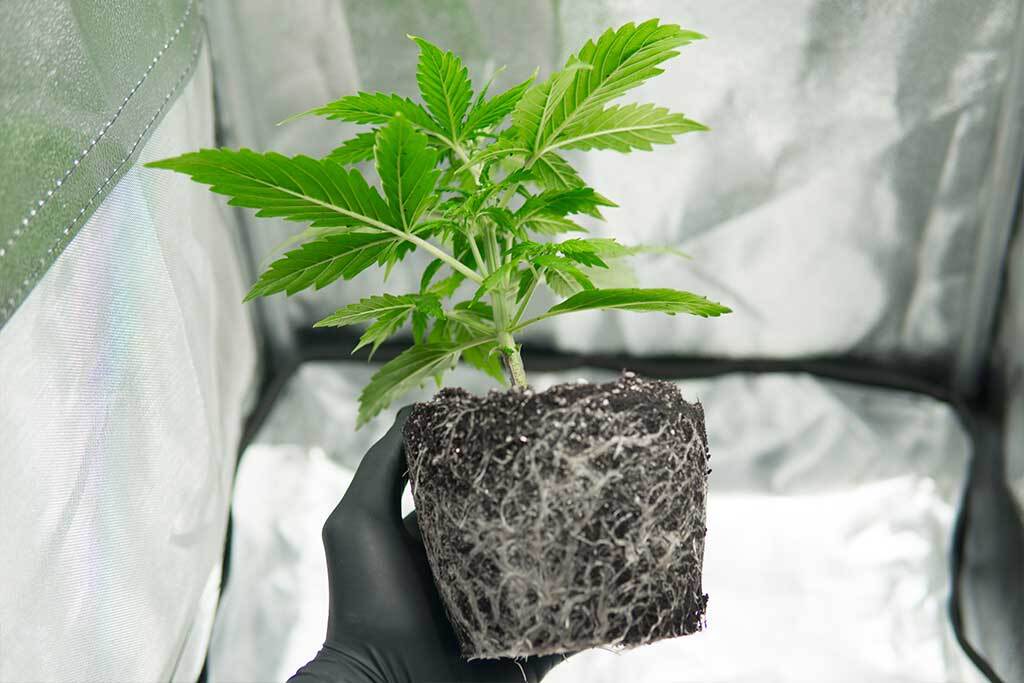When And How to Transplant Cannabis Plant? The Top Answers to Transplanting Questions

When growing cannabis you typically have one goal in mind - to grow the biggest, strongest and healthiest plants possible. One technique to achieve this goal is transplanting cannabis plants to bigger pots throughout their life cycle. So here, we’ll cover all the dos and don’ts of successfully repotting cannabis plants. Including, when to transplant cannabis plants, how to transplant a plant successfully, and why you should transplant, too.
The Benefits of Cannabis Transplanting
The first thing’s first - to define what cannabis transplanting or repotting means, it’s just the simple act of moving your plant from a smaller container to a bigger container. It’s common amongst professional and home growers who are seeking to boost health, and gains from their cannabis crops. The two main benefits of cannabis transplanting include -
Avoiding rootbound plants
Healthy roots equal healthy plants, and to keep roots healthy you’ll need to avoid them becoming ‘rootbound’. Because roots expand into mediums to seek out nutrients, when they reach the edge of a pot or container they’ll begin to circle the edge. As they do so, they can become entangled in themselves as they wrap tighter and tiger, becoming ‘rootbound’. This means, rootbound roots essentially choke themselves and lead to sickly plants and even stunted or halted growth, altogether. By transplanting plants into larger pots as they grow, you can give the roots ample space to grow and stretch to remain healthy.
Stronger healthier plants
The result of giving roots what they need by transplanting cannabis plants into bigger pots, is stronger, healthier plants overall.
So, now that you know the unique benefits of repotting, you’re likely wondering when to transplant cannabis for optimal results? Let’s cover transplanting timing, next.
When Should I Transplant seedlings?
Like many things in cannabis, when to transplant weed seedlings and veg plants is mostly intuitive with a few signs to look for when deciding what time is right. Normally, growers will re-pot or transplant cannabis plants at least 1-2 times. Usually, right after the seedling stage and after veg into their final container. For example, you may transplant your seedling from a solo cup into a 1-2 gallon pot, and after veg transplant that 1-2 gallon pot into a 5-10+ gallon pot. However, this can vary depending on the exact plant size, pot size, or grow room size, too. Here are a few indicators to keep in mind when deciding when or how to begin cannabis transplanting -

Monitor the size of the plant or # of leaves
Simply put, if a plant looks too big for the container it’s in then, it’s likely time to transplant. You’ll also want to watch the number of nodes and time the cannabis transplanting when growth is accelerating in the small container. That way, the plant will continue to grow rapidly and healthily in its new space without stunting first.
Use life cycle as timing
Similar to monitoring the size of the plant and number of leaves, you can use your plant’s life cycle timing as a way to decide when to transplant, too. Most growers will automatically transplant when transitioning from the seedling stage to veg, and the veg stage to flowering.
Check root development from drainage holes
If you see roots escaping from the bottom of your pot through drainage holes - then it’s definitely time to transplant. With fabric containers, this can be more difficult to see visually. So, be sure to watch for signs like droopy leaves or yellowing spots, that aren’t caused by a nutrient deficiency. These symptoms might be a sign of rootbound and you should consider transplanting cannabis pots to address.
Drying out or tipping over pots
When your medium is drying out quickly, that means your plant is drinking up more water than the container can hold. This may result in pots or containers tipping over, which can cause unnecessary stress to the plant. If you notice your plant’s medium drying out quicker than usual, it’s likely time to transplant it to a bigger container.
As a guide, you’ll always want to make sure to double the size of the pot that you’re transplanting your plant into. I.e. transplanting a 2-gallon pot into at least a 4-gallon pot, etc. In general, here are the recommended pot sizes for plant heights as they grow -
| Plant height (inches) | Pot size |
| 0-6″ | 16 oz. |
| 6-12″ | 1-gallon |
| 12-24″ | 3-gallon |
| 24-42″ | 5-gallon |
| 42-60″ | 10-gallon |
| 60-84″ | 20-gallon |
If you’re transplanting for the first time or have stumbled transplanting in the past, next let’s cover a few general tips and best practices for doing so successfully.
Best Practices for Successful Cannabis Transplanting

Of course, keep in mind there is such a thing as cannabis transplant shock. If not done correctly, you can shock your cannabis plant which may result in stunted, or halted growth. Or, can negatively affect the overall health and quality of your plant in general. The two biggest things to keep in mind when transplanting cannabis plants are to avoid root damage (use caution and be careful!) and promote cleanliness. To nurture optimal and quality growth keep the following best practices in mind for a successful cannabis transplant -
- Wash hands, and ensure a clean working space.
- Water plants 1-2 days prior to transplanting. It’s easiest to transplant cannabis plants when the medium is moist but not overly wet.
- Before transplanting your plant, fill the new container or pot with a light base of soil/medium. You can sprinkle mycorrhizae on top of the new soil which is a beneficial fungus that promotes nutrient uptake for roots and optimal growth overall.
- Water the new soil, and water the plant after transplanting too. Immediate moisture will help your plant uptake water more optimally, as it continues to grow. You’ll also want to avoid overpacking the soil, to allow roots to grow freely and vigorously and avoid drainage issues.
- If you’re having an issue removing the plant from its smaller container, do your best not to disturb or agitate the roots in the process. Lightly squeeze the sides of the container, and tip the plant upside down to remove carefully and slowly. With stubborn plants, you can use a butter knife around the edge of the plant to gently detach the roots from the side of the container.
The Final Word on Transplanting Cannabis Plants
Now that you know the when’s, why’s, and how’s of transplanting cannabis plants you can begin to grow bigger, healthier, and stronger crops. By following these do’s and don’ts of successful cannabis transplanting, your plants should not only survive but thrive. Stay in tune and in touch with MSNL for invaluable growing tips and shop our collection for high-quality cannabis genetics and seeds, now.
-
20+ Years Experience
Over 500K seeds sold worldwide
100K+ Happy Customers -
Germination Guaranteed
Complete satisfaction or we will replace your order -
Dutch and USA Genetics
Master breeders inspiring strains from across the world -
1-5 Day Delivery - Guaranteed
Free Express Shipping to the US, Canada and UK








